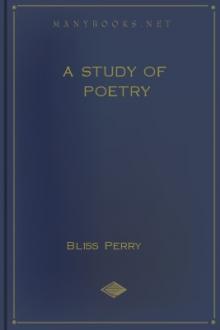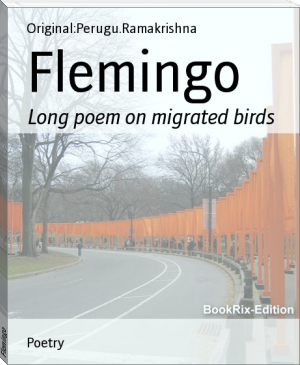A Study of Poetry by Bliss Perry (top 10 books of all time txt) 📕

- Author: Bliss Perry
- Performer: -
Book online «A Study of Poetry by Bliss Perry (top 10 books of all time txt) 📕». Author Bliss Perry
“It is a well-known property of human speech that it keeps up a ceaseless change between accented and unaccented syllables. A long succession of accented syllables becomes unbearably monotonous; a long succession of unaccented syllables is, in effect, impossible. Now when the ear detects at regular intervals a recurrence of accented syllables, varying with unaccented, it perceives Rhythm. Measured intervals of time are the basis of all verse, and their regularity marks off poetry from prose; so that Time is thus the chief element in Poetry, as it is in Music and in Dancing. From the idea of measuring these time-intervals, we derive the name Metre; Rhythm means pretty much the same thing,—‘a flowing,’ an even, measured motion. This rhythm is found everywhere in nature: the beat of the heart, the ebb and flow of the sea, the alternation of day and night. Rhythm is not artificial, not an invention; it lies at the heart of things, and in rhythm the noblest emotions find their noblest expression.”
GUMMERE, Handbook of Poetics, p. 133.
4. “It was said of Chopin that in playing his waltzes his left hand kept absolutely perfect time, while his right hand constantly varied the rhythm of the melody, according to what musicians call tempo rubato,‘stolen’ or distorted time. Whether this is true in fact, or even physically possible, has been doubted; but it represents a perfectly familiar possibility of the mind. Two streams of sound pass constantly through the inner ear of one who understands or appreciates the rhythm of our verse: one, never actually found in the real sounds which are uttered, is the absolute rhythm, its equal time-intervals moving on in infinitely perfect progression; the other, represented by the actual movement of the verse, is constantly shifting by quickening, retarding, strengthening or weakening its sounds, yet always hovers along the line of the perfect rhythm, and bids the ear refer to that perfect rhythm the succession of its pulsations.”
ALDEN, An Introduction to Poetry, p. 188.
5. “Many lines in Swinburne cannot be scanned at all except by the Lanier method, which reduces so-called feet to their purely musical equivalents of time bars. What, for instance, can be made by the formerly accepted systems of prosody of such hexameters as
‘Full-sailed, wide-winged, poised softly forever asway?’
The usual explanation of this line is that Mr. Swinburne, carelessly, inadvertently, or for some occult purpose, interjected one line of five feet among his hexameters and the scansion usually followed is by arrangement into a pentameter, thus:
‘Full-sailed | wide-winged | poised softly | forever | asway,’
the first two feet being held to be spondees, and the third and fourth amphibrachs. It has also been proposed to make the third foot a spondee or an iambus, and the remaining feet anapaests, thus:
‘Full-sailed | wide-winged | poised soft- | ly forev- | er asway.’
“The confusion of these ideas is enough to mark them as unscientific and worthless, to say nothing of the severe reflection they cast on the poet’s workmanship. We have not so known Mr. Swinburne, for, if there be anything he has taught us about himself it is his strenuous and sometimes absurd particularity about immaculate form. He would never overlook a line of five feet in a poem of hexameters. But—as will, I think, appear later and conclusively—the line is really of six feet, and is not iambic, trochaic, anapaestic, the spurious spondaic that some writers have tried to manufacture for English verse, or anything else recognized in Coleridge’s immortal stanza, or in textbooks. It simply cannot be scanned by classical rules; it cannot be weighed justly, and its full meaning extracted, by any of the ‘trip-time’ or ‘march-time’ expedients of other investigators. It is purely music; and when read by the method of music appears perfectly designed and luminous with significance. Only a poet that was at heart a composer could have made such a phrase, based upon such intimate knowledge of music’s rhythmical laws.”
C. E. RUSSELL, “Swinburne and Music” North American Review, November, 1907.
6. Dr. Henry Osborn Taylor has kindly allowed me to quote this passage from his Classical Heritage of the Middle Ages, pp. 246, 247:
“Classic metres expressed measured feelings. Hexameters had given voice to many emotions beautifully, with unfailing modulation of calm or storm. They had never revealed the infinite heart of God, or told the yearning of the soul responding; nor were they ever to be the instrument of these supreme disclosures in Christian times. Such unmeasured feelings could not be held within the controlled harmonies of the hexameter nor within sapphic or alcaic or Pindaric strophes. These antique forms of poetry definitely expressed their contents, although sometimes suggesting further unspoken feeling, which is so noticeable with Virgil. But characteristic Christian poetry, like the Latin mediaeval hymn, was not to express its meaning as definitely or contain its significance. Mediaeval hymns are childlike, having often a narrow clearness in their literal sense; and they may be childlike, too, in their expressed symbolism. Their significance reaches far beyond their utterance; they suggest, they echo, and they listen; around them rolls the voice of God, the infinitude of His love and wrath, heaven’s chorus and hell’s agonies; dies irae, dies illa—that line says little, but mountains of wrath press on it, from which the soul shall not escape.
“Christian emotion quivers differently from any movement of the spirit in classic measures. The new quiver, the new shudder, the utter terror, and the utter love appear in mediaeval rhymed accentual poetry:
Desidero te millies,
M� Jesu; quando venies?
Me laetum quando facies,
Ut vultu tuo saties?
Quo dolore
Quo moerore
Deprimuntur miseri,
Qui abyssis
Pro commissis
Submergentur inferi.
Recordare, Jesu pie,
Quod sum causa tuae viae;
Ne me perdas ilia die.
*
Lacrymosa dies illa
Qua resurget ex fa villa,
Judicandus homo reus;
Huic ergo parce, Deus!
Pie Jesu, Domine,
Dona eis requiem.
“Let any one feel the emotion of these verses and then turn to some piece of classic poetry, a passage from Homer or Virgil, an elegiac couplet or a strophe from Sappho or Pindar or Catullus, and he will realize the difference, and the impossibility of setting the emotion of a mediaeval hymn in a classic metre.”
7. “Friends: I know how vain it is to gild a grief with words, and yet I wish to take from every grave its fear. Here in this world, where life and death are equal things, all should be brave enough to meet what all the dead have met. The future has been filled with fear, stained and polluted by the heartless past. From the wondrous tree of life the buds and blossoms fall with ripened fruit, and in the common bed of earth, the patriarchs and babes sleep side by side.
“Why should we fear that which will come to all that is?
“We cannot tell, we do not know, which is the greater blessing—life or death. We do not know whether the grave is the end of this life, or the door of another, or whether the night here is not somewhere else at dawn. Neither can we tell which is the more fortunate—the child dying in its mother’s arms, before its lips have learned to form a word, or he who journeys all the length of life’s uneven road, painfully taking the last slow steps with staff and crutch.
“Every cradle asks us, ‘Whence?’ and every coffin, ‘Whither?’ The poor barbarian, weeping above his dead, can answer these questions as intelligently as the robed priest of the most authentic creed. The tearful ignorance of the one is just as consoling as the learned and unmeaning words of the other. No man, standing where the horizon of a life has touched a grave, has any right to prophesy a future filled with pain and tears. It may be that death gives all there is of worth to life. If those we press and strain against our hearts could never die, perhaps that love would wither from the earth. Maybe this common fate treads from out the paths between our hearts the weeds of selfishness and hate, and I had rather live and love where death is king, than have eternal life where love is not. Another life is naught, unless we know and love again the ones who love us here.
“They who stand with aching hearts around this little grave need have no fear. The larger and the nobler faith in all that is and is to be tells us that death, even at its worst, is only perfect rest. We know that through the common wants of life—the needs and duties of each hour—their griefs will lessen day by day, until at last this grave will be to them a place of rest and peace—almost of joy. There is for them this consolation. The dead do not suffer. And if they live again, their lives will surely be as good as ours. We have no fear. We are all children of the same mother, and the same fate awaits us all.
“We, too, have our religion, and it is this: Help for the living, hope for the dead.”
ROBERT G. INGERSOLL, “Address over a Little Boy’s Grave.”
I have not attempted in this chapter to give elaborate illustrations of the varieties of rhyme and stanza in English poetry. Full illustrations will be found in Alden’s English Verse. A clear statement of the fundamental principles involved is given in W. H. Carruth’s Verse Writing.
Free verse is suggestively discussed by Lowes, Convention and Revolt, chapters 6 and 7, and by Andrews, Writing and Reading of Verse, chapters 5 and 19. Miss Amy Lowell has written fully about it in the Prefaces to Sword Blades and Poppy Seed and Can Grande’s Castle, in the final chapter of Tendencies in Modern American Poetry, in the Prefaces to Some Imagist Poets, and in the North American Review for January, 1917. Mr. Braithwaite’s annual Anthologies of American Verse give a full bibliography of special articles upon this topic.
An interesting classroom test of the difference between prose rhythm and verse rhythm with strongly marked metre and rhyme may be found in comparing Emerson’s original prose draft of his “Two Rivers,” as found in volume 9 of his Journal, with three of the stanzas of the finished poem:
“Thy voice is sweet, Musketaquid, and repeats the music of the ram, but sweeter is the silent stream which flows even through thee, as thou through the land.
“Thou art shut in thy banks, but the stream I love flows in thy water, and flows through rocks and through the air and through rays of light as well, and through darkness, and through men and women.
“I hear and see the inundation and the eternal spending of the stream in winter and in summer, in men and animals, in passion and thought. Happy are they who can hear it.”
“Thy summer voice, Musketaquit,
Repeats the music of the rain;
But sweeter rivers pulsing flit
Through thee, as thou through Concord plain.
“Thou in thy narrow banks are pent;
The stream I love unbounded goes
Through flood and sea and firmament;
Through light, through life, it forward flows.
“I see the inundation sweet,
I hear the spending of the stream
Through years, through men, through nature





Comments (0)